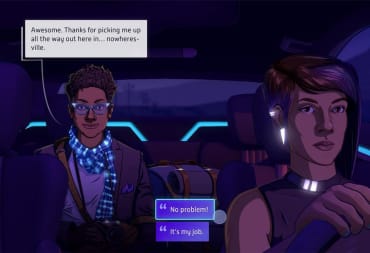Have you ever wondered what it would be like to live in a world where one megacorporation controls almost everything in your life? Same here. That’s why I played Neo Cab, a near-future cyberpunk title by Chance Agency. Cyberpunk stories always reflect on modern culture in some way, often at the intersection between rampant technological growth and whatever makes us human. Neo Cab does something similar, and the ride-share mechanic sells its message in a five-star way.
You play as Lina, one of the last remaining Neo Cab drivers in Los Ojos, California. If you’ve been in a Lyft or Uber, you know exactly what Neo Cab is. However, jump forward in time by a few years, because megacorporation Capra has replaced most—if not all—cars with autonomous Capra Cars.
You try to survive as a ride-share driver in a world that doesn’t want humans behind the wheel, and that experience elevates the themes of this visual novel to a new level.

Visual novels aren’t necessarily for everyone, and I certainly can’t say I’m an avid fan of them. Yet, the ride-sharing metagame Chance Agency created in Neo Cab made it feel less like a visual novel. You decide who to pick up, which determines what dialogue you see.
These moments play out like vignettes as if we get a vertical slice of the weird life of Los Ojos. Furthermore, my own choices directly impacted who I spoke to and how I experienced the visual novel. Before me was a book about Los Ojos, and I pulled out passages piecemeal, stitching little narratives together like a puzzle.
For example, early in the story, I picked up a couple who met on a dating app. It’s their first date, and they clearly don’t mesh well. Anthony takes a hippie-dippie, freestyling approach to life, while Risa seems to calculate every breath she takes. She also bears a grudge against human drivers, which makes things a little tense in the car. The date ends horribly, as you can imagine.
The next night, however, I saw that Risa and Anthony were looking for rides (separately, of course). I chose to pick up Risa; while Anthony was nicer to me, he was a little too nice. Over the next few nights, Risa became a regular passenger in my Neo Cab, and her story unfolded right there in the backseat. She has a fear of human drivers because they make more errors than robots, which she considers perfect. She also creates robots, but she holds herself to such a high standard that she loses sleep perfecting them.
Between her visits, I had others in the car. I met a kooky “doctor” for the people, who learned everything by watching videos online. A German couple failed to believe I was a human because robots were becoming so lifelike. But I kept returning to Risa when I could because I wanted to see her tale through to the end. This storytelling method put me in control, giving me agency over how I want to experience the narrative. In other words, Neo Cab gamifies the visual novel experience, and it compels because every interaction comes from a relatable place.

When you’re deciding who to pick up, you open a little map of Los Ojos. People drop pins, requesting a Neo Cab. Other pins highlight the various refueling stations around the city. You may be driving a future car, but it’s grounded in that it still needs some sort of fuel. When you highlight someone, you’ll see a little description of their profile. Some people mention their occupation, while one guy simply put something like, “Setting up my Neo Cab profile!” Despite the futuristic tech and neon lights, it was all extremely relatable because we’ve all created and read profiles before.
Furthermore, many people have used ride-sharing services before. Neo Cab simply puts us on the other side of the equation. Many of us have been in cars, as drivers and passengers alike, and there’s something intimately familiar about the language of that setting. Sitting in the backseat sets a specific tone compared to sitting shotgun. There’s also an air of detachment while looking into the driver’s eyes through the rearview mirror. For some, that makes it easier to open up. Others may clam up instead. Again, through all the synthetic body parts, self-driving cars, and holographic phones, Neo Cab’s setting paints a picture that’s easy to relate to.
Our protagonist Lina plays another vital role in making Neo Cab’s bleak future feel a little more real. She experiences a lot of emotions, and she can be neurotic and anxious, depending on how she reads people. Nonetheless, she’s trying to learn about the technological life in Los Ojos. In her internal monologue, she worries about how the person in the backseat might react to her views. Bringing Risa back up, her fear of human drivers raises many questions for Lina—and by extension, for the player.
As we hurdle toward a future with self-driving cars, these questions become more salient with every passing day. Lina simply becomes the vector for us as we dive into this near-future cyberpunk hellscape.
This post was originally published in 2019 as part of our Bullet Points series. It's been republished to have better formatting and images.
Have a tip, or want to point out something we missed? Leave a Comment or e-mail us at tips@techraptor.net












